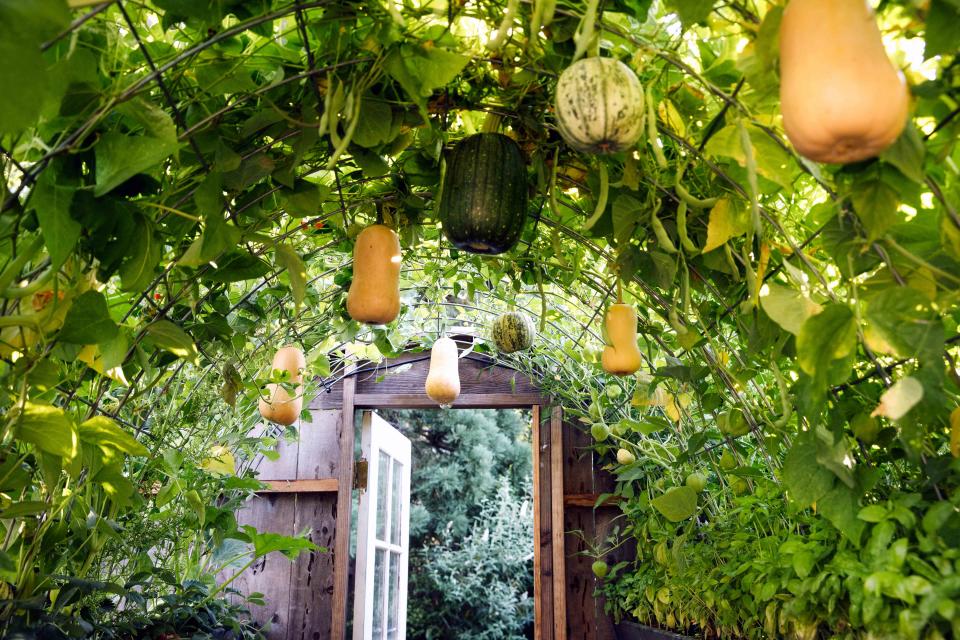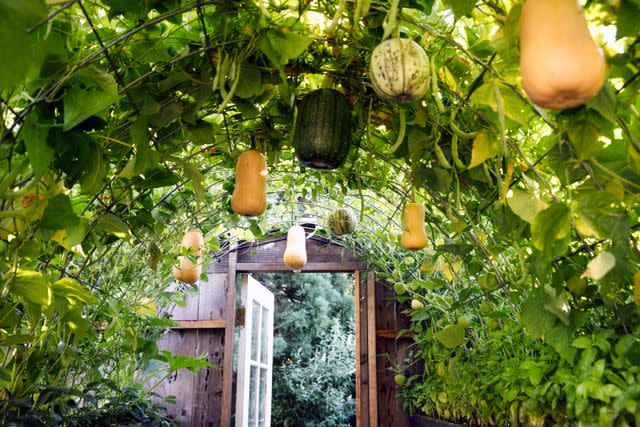How to Grow Squash Vertically to Save Space
Use these tips to grow squash vertically and maximize your harvest.

Jessica Sample
Squash are prolific plants to grow in gardens, from winter squash like butternuts to summer squash such as zucchini. But many types of squash plants can get quite large and their sprawling vines can overwhelm smaller vegetables and other nearby plants. However, if you grow squash vertically, you can fit squash plants in even the smallest urban garden. Plus, trellising squash offers other benefits too. Use this guide to train squash vines to grow vertically and find the best trellis options to use.

Jessica Sample
Benefits of Growing Squash Vertically
Squash don’t technically need trellises and there are some bush-type squash that stay so compact that they don’t need extra support. But if you want to grow vining squash in a small space or mixed bed garden, growing squash vertically can save you a lot of space and there are other benefits too.
Space saving. Training squash to grow vertically will keep plants from spreading, allowing you to fit more plants in your garden. In fact, trellised squash plants take up so little space that you may even be able to grow them on a balcony garden.
Cleaner produce. Squash that’s grown vertically doesn’t touch the soil and will be much cleaner when you pick it.
Fewer pests and diseases. When squash vines grow on trellises, they receive more sun and air can pass through their leaves with ease. This reduces the chance that diseases like powdery
mildew will develop and vertical squash vines are also much easier to inspect for pests.More attractive squash. Growing squash vertically prevents the unsightly discoloration on squash bottoms that often occurs when squash is allowed to sit directly on damp earth. Additionally, if you like growing long squash varieties, such as tromboncino squash, trellising them will allow you to produce straighter squash.
Steps for Growing Squash Vertically
The following steps will walk you through installing your trellis and supporting squash vines as they grow.
1. Install the trellis.
Before you plant anything, first install your trellises. This will ensure that you don’t accidentally disturb seeds or plants as they grow. How you install a trellis will depend on the type of trellis you’re using. Some trellises, like cattle panels, are usually installed into garden beds with T-posts or other supports, while hanging trellises can be mounted to walls and sunny porches with eyehooks or other hardware.
2. Plant squash seeds.
Once your trellis is installed, it’s time to plant your squash. Use the directions on your seed packet to determine the proper spacing and planting depth of the particular type of squash you’re growing.
Also keep in mind that some trellises can bear more weight than others. Lightweight trellises made of string or bamboo may just be able to hold one squash vine, while sturdier trellises like cattle panels can usually support at least 3 to 5 vines.
Related:Burpee’s Viral ‘Rise and Shine’ Summer Squash Is Finally Back in Stock
3. Add water.
Whether you grow squash plants vertically or not, they require the same basic care, which includes regular watering and fertilizer. However, plants that are kept on trellises may need to be watered a bit more often. This is because squash vines that grow in the garden may root at several points along their vines, which gives them more access to water. Vertical plants, however, only have one point of contact with the soil, so they may need to be watered more often.
4. Apply mulch.
All squash plants can benefit from mulching, which reduces water evaporation rates, keeps fruit cleaner, and prevent weeds too. Mulches, like straw or salt marsh hay, work beautifully for squash vines and they should be applied after your plant has sprouted.
Related:8 Essential Tips for Mulching with Straw in Your Vegetable Garden
5. Train squash vines.
Training squashes to grow vertically is not difficult, but you do need to be consistent with it. As plants begin to send out their first tendrils, carefully guide these stems around your trellises to encourage your plants to grow up. As the plants get bigger, you may want to anchor vines to your trellis with garden twine, plant ties, or plant clips, but these should be loosely attached to plants so they don’t inhibit vine growth.
6. Add extra support.
As squash vines grow and begin to produce fruit, they may need some extra support to prevent vines from breaking under the weight of developing squash. This is particularly important for larger squash types, like acorn and butternut squash.
Pantyhose are a budget-friendly option to support developing squash. gently slip your squash into the pantyhose and then secure it to your trellis to take the weight off the vine. The pantyhose will expand as the squash grows.
Easy Squash Trellis Ideas
You can find a lot of premade trellis options for squash growing, although you can also make your own DIY trellises too. Which trellis you decide to use will depend on your available growing space and how many squash vines you’d like to keep.
A-frame trellises work best in larger gardens. They can support several vines each.
Tower trellises or obelisk trellises are upright trellis options that don’t take up a lot of space and they are easy to make with bamboo poles. While these trellises are ideal for small gardens and even balconies, they won’t hold as many squash vines.
Cattle panel trellises are an inexpensive DIY option that can support a number of squash vines. Cattle panels can be secured to T-posts or they can be mounted to garden walls. They are also flexible enough that they can be bent into creative shapes like archways.
Flat trellises are often made of wood or metal and they can be mounted in the garden or against a wall. These trellises are small-space-friendly and they come in traditional and contemporary styles.
Trellis netting is a budget-friendly choice that can be hung from porch or balcony ceilings in urban gardens. Netting may not last as long as some other trellises, but it is very convenient to use and it should last for several years if properly maintained.
Best Squash to Grow Vertically
While you can grow any vining squash vertically, you’ll have better success with smaller plants. As fun as Hubbard squash and pumpkins are to grow, they can get quite massive and their vines are more likely to overwhelm a limited space. On the other hand, squash vines that produce smaller fruit won’t grow as large and their fruit won’t need as much extra support.
Some of the most popular squash types to grow with trellising include:
Summer squash
Zucchini
Butternut squash
Sweet dumpling squash
Delicata squash
Acorn squash
Calabash
Related:How to Plant and Grow Gourds
For more Better Homes & Gardens news, make sure to sign up for our newsletter!
Read the original article on Better Homes & Gardens.

